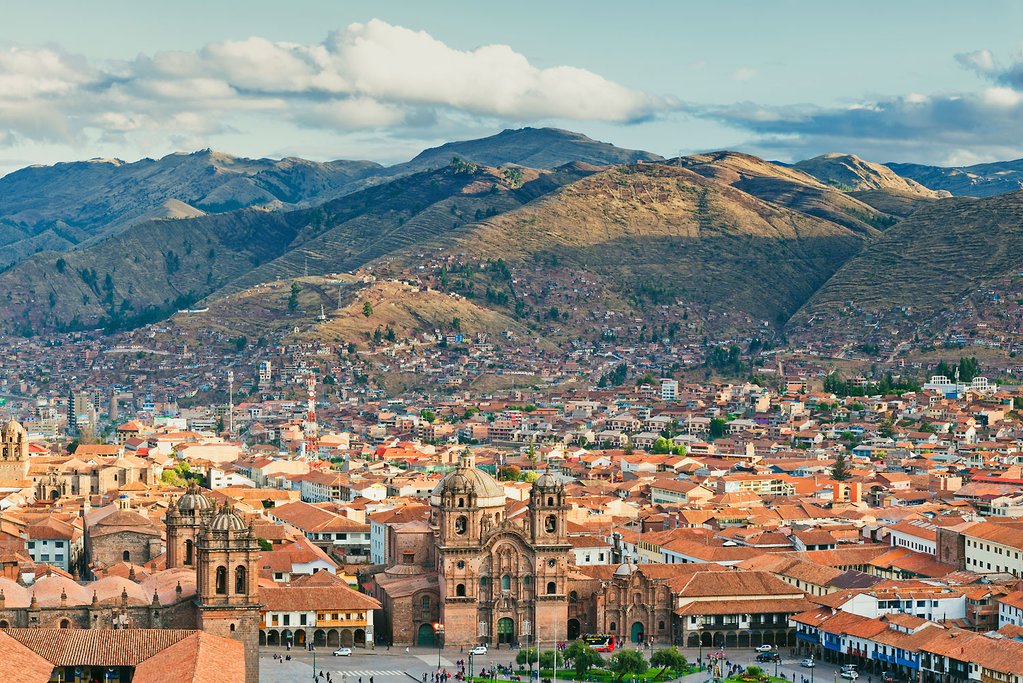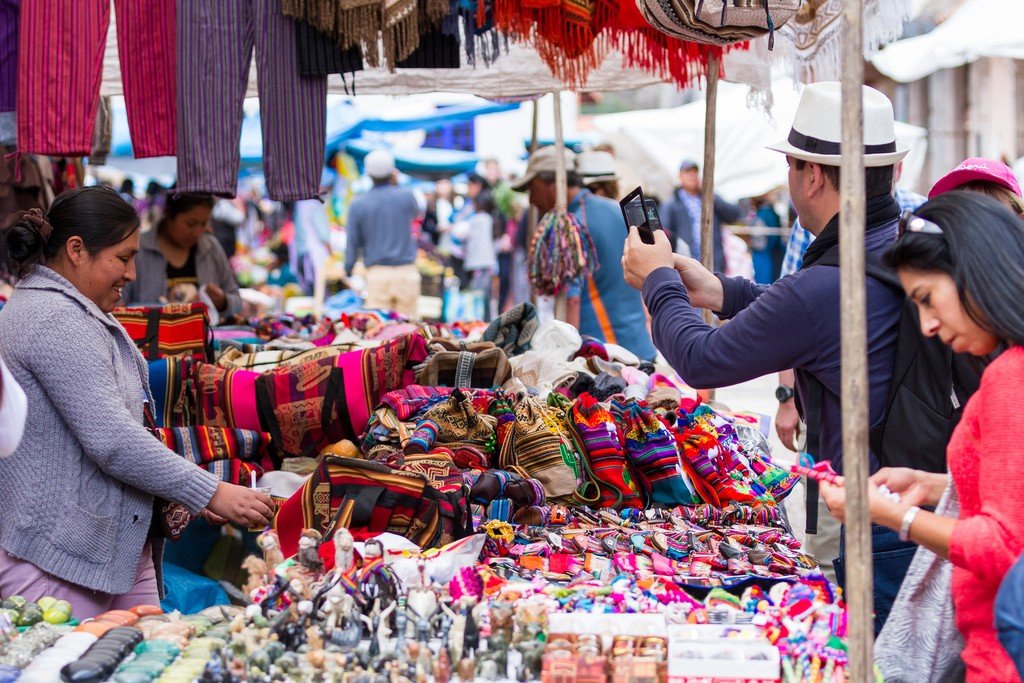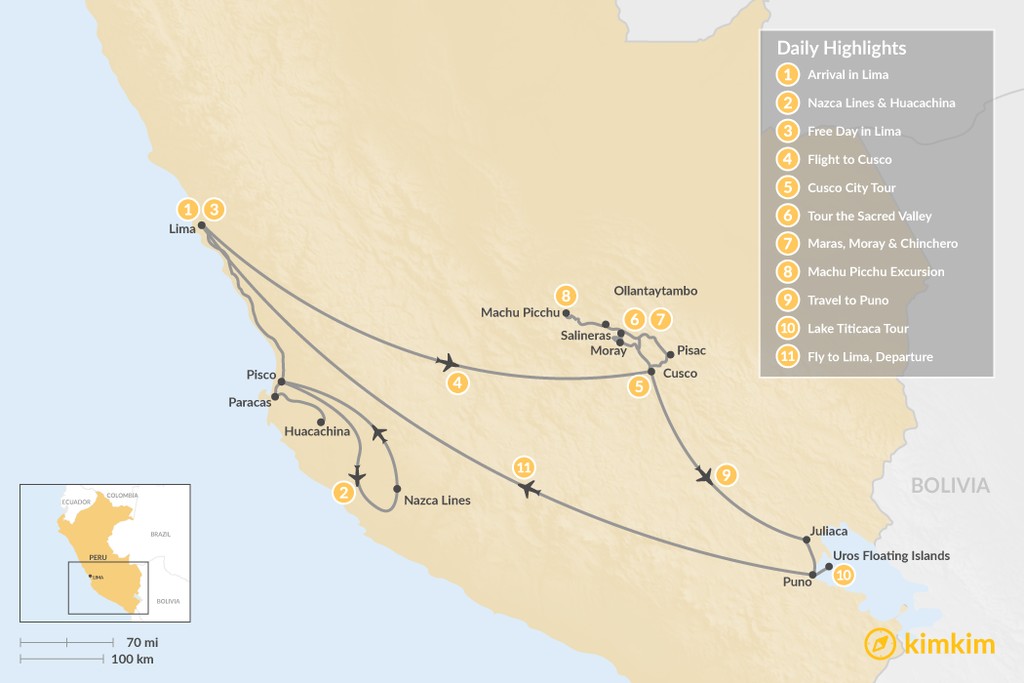Highlights
- Get an aerial view of some of the world's most impressive geoglyphs
- Explore Cusco's ancient heritage and modern culture
- Spend a day touring the ancient citadel of Machu Picchu
- Take in the beauty of Lake Titicaca
Brief Itinerary
| Day | Highlights | Overnight |
|---|---|---|
| Day 1 | Arrival in Lima | Lima |
| Day 2 | Nazca Lines & Huacachina Adventure: Lima - Nazca Lines - Huacachina - Paracas | Paracas |
| Day 3 | Free Day in Lima - History & Museums: Paracas to Lima | Lima |
| Day 4 | Arrival in Cusco, Exploring the City | Cusco |
| Day 5 | Cusco City Tour | Cusco |
| Day 6 | Tour the Sacred Valley: Cusco - Pisac - Ollantaytambo | Ollantaytambo |
| Day 7 | Maras & Moray Tour & Train to Aguas Calientes | Aguas Calientes |
| Day 8 | Machu Picchu Excursion: Aguas Calientes - Machu Picchu - Cusco | Cusco |
| Day 9 | Arriving in Puno: Cusco - Puno | Puno |
| Day 10 | Lake Titicaca Tour: Uros Floating Islands & Taquile Island | Puno |
| Day 11 | Fly from Puno to Lima, Depart Peru |
Detailed Itinerary
Day 1: Arrival in Lima

¡Bienvenidos! Welcome to Lima, Peru's largest city and central metropolitan hub, and home to one-third of the country's population. Located at the site of a pre-Columbian indigenous Ychsma settlement, which was conquered by the Inca empire in the 15th century and later by the Spanish conquistadores, Lima has a fascinating history and a diverse mix of cultures. Amerindian, European, Afro-Peruvian, and Asian—especially Chinese and Japanese—influences make Lima a dynamic and exciting city to explore.
Lima's breezy location on the Pacific Ocean and mild desert climate make it an excellent city for exploring on foot. Head downtown to mingle with locals, stretch your legs, and grab a bite to eat in one of the city's many award-winning restaurants.
Suggested activities include:
- Explore the historic center of Lima, a UNESCO World Heritage Site packed with fascinating Spanish architecture. Start with a scenic tour of the colonial downtown, which emanates from the main square. Stroll over to the 16th-century Cathedral, which took 80 years to construct and was built in the grandiose style of the Spanish Empire.
- Visit the Casa Aliaga, a colonial mansion granted by chief conquistador Francisco Pizarro to Jerónimo de Aliaga, one of his captains, in 1535. This is the only house from that era that still belongs to the same family.
- Stroll around the Pueblo Libre district to the privately owned Larco Museum of pre-Columbian art, housed in a beautifully restored viceregal mansion built over a seventh-century pre-Columbian pyramid. The museum boasts a vast pre-Colonial collection of gold and silver artifacts.
- In the evening, head to the eclectic "Love Park" in the upscale coastal district of Miraflores, where you can admire a huge kissing statue and beautiful mosaic walls. The park is built on the cliffs of Chorrillos and is a perfect place to enjoy a spectacular sunset over the Pacific.
- Enjoy a nightcap at an open-air cafe or restaurant in the diverse Miraflores neighborhood.
Day 2: Nazca Lines & Huacachina Adventure: Lima - Nazca Lines - Huacachina - Paracas

Your day begins with an early pickup from your hotel in Lima, followed by a scenic four-hour drive along the coast south to the seaside town of Paracas. After arriving, transfer to the nearby airport in Pisco. From here, you will take a 90-minute flight south aboard a 12-passenger plane to view the sprawling Nazca Lines. You'll get a chance to see many of the most famous geoglyphs: hummingbird, dog, tree, whale, lizard, and more.
These massive images, measuring up to 1,200 feet in length, vary from geometric lines to figures of animals and people. Due to the stable environment of the Nazca desert, these geoglyphs—which were created by removing the top layer of iron-oxide coated pebbles to reveal the light-colored clay underneath—have been remarkably well-preserved.
After the flight, head to Huacachina for an adventure in the desert sand dunes. Hop on a sandboard to surf down the larger dunes. In the evening, transfer to your hotel in Paracas.
Day 3: Free Day in Lima - History & Museums: Paracas to Lima

After breakfast, transfer from Paracas back to Lima. Take the rest of today to explore Lima's art, architecture, and history at your leisure. Take a stroll along the Miraflores clifftops with their lovely landscaped parks and slot in an afternoon of culture with visits to either the Museo de Arte Contemporaneo (Museum of Contemporary art) or the restored pyramid of Huaca Pucllana.
Set aside part of the day for exploring the historic center of Lima. Start on Plaza Mayor with the cathedral, which contains the remains of city founder Francisco Pizarro. Striking facades are visible from every angle: look for the Moorish balconies of Palacio Arzobispal and the beautiful baroque Palacio de Gobierno, home of Peru's President. Other architectural highlights include the city's most captivating church, the Iglesia de Santo Domingo.
End the day by enjoying a delicious dinner at one of Lima's best restaurants, then head out for pisco sours—Peru's national cocktail.
Day 4: Arrival in Cusco, Exploring the City

Head to the Lima airport for your transfer flight to Cusco. This ancient city is the former capital of the Inca empire, in power from the 13th to 16th centuries after conquering the Killke settlement on the same location.
Remember: you'll be 11,000 feet above sea level, so take it easy and remember to drink lots of water. Since Cusco was designed by the Incas as a city for walking, start your exploration of the narrow stone alleyways on foot. Take a walk through the plaza—if the weather is good, it's a nice place to sit on a balcony and have a cup of coca tea while adjusting to the elevation.
Suggested activities include:
- See the Cathedral, the most imposing monument in the central Plaza de Armas and a repository for Cusco's colonial art. Its construction lasted for almost 100 years, beginning in 1560 and ending in 1654.
- Discover the elaborate Puca Pucara ruins—an architectural complex with multiple plazas, baths, aqueducts, walls, and towers. It is believed that the entourage of the Incan emperor used it while he stayed at Tambomachay, the elaborate estate and baths nearby.
- Explore San Blas, an old bohemian quarter famous for its picturesque white walls, blue doors, and creative artisan community.
- Eat lunch at a local Peruvian restaurant and sample local flavors and cooking techniques—crackling pork, pickled vegetables, seasonal flavors, bread baked in earthen ovens, roasted vegetables, and sweet donuts make for a delicious and filling meal.
Chat with a local specialist who can help organize your trip.
Day 5: Cusco City Tour

Today's tour will begin at the local San Pedro Market. The locals shop at this market every day in order to stock up on produce and groceries. The market is located indoors and includes many different food stalls and vendors. Be sure to try a fresh fruit smoothie. From the market, you'll head to the most important temple of the Inca Empire, the Sun Temple, known as Qoricancha. Inside, you'll see smaller temples dedicated to the moon, rainbow, stars, lightning, and thunder, among others.
Next, you'll walk to an important religious site called Sacsayhuaman. Although the site was originally used for religious purposes, the Spanish considered it a military fortress because of its location and the way it was built.
Day 6: Tour the Sacred Valley: Cusco - Pisac - Ollantaytambo

Leave Cusco and drive into the Sacred Valley en route to Pisac, a village known for its traditional market and large Inca fortress. During the day, you'll have plenty of opportunities to stop for photos as you pass terraces, irrigation canals, and picturesque mountain views.
In the afternoon, continue on to the town of Ollantaytambo, which contains some of the best-preserved Inca architecture in the entire Sacred Valley. Wander through the town's winding alleys and pretty plazas—and gaze upon an intriguing llama-shaped ruin—before heading to a local hotel for the night.
Day 7: Maras & Moray Tour & Train to Aguas Calientes

This morning, leave Ollantaytambo for the journey to Moray. Along the way, you will see the snow-capped peaks of the Andes and yellow fields of wheat. Upon arrival in Moray, you'll tour the three famous amphitheater-like terraces made by the Incas. These terraces are carved deep into the earth in the shape of a bowl. It is believed that the Incas once used these terraces as agricultural laboratories to determine the optimal conditions for growing crops.
When you are done exploring Moray, you will head about two miles away, to the salt mines of Maras. The village is thought to date back to pre-Incan times. There are over 3,000 salt pools carved into the mountainside: each is filled daily by a stream of water. Next, head back to Ollantaytambo in time to catch your train to Aguas Calientes.
Day 8: Machu Picchu Excursion: Aguas Calientes - Machu Picchu - Cusco

Get an early start to beat the crowds and get the best views of the ancient ruins. From Aguas Calientes, it's an easy 25-minute bus ride up to Machu Picchu.
This 15th-century Inca citadel is a masterpiece of engineering that served as a sanctuary and retreat for the Incan Emperor Pachacutec and his royal court. Machu Picchu, which means "Old Mountain," is considered a World Heritage Site by UNESCO and is one of the new Seven Wonders of the World.
Built as a seasonal residence for the Inca family, Machu Picchu was rarely home to more than 800 people; during the royals' absence, just 100 servants would remain at the site to maintain the grounds. Machu Picchu was abandoned 100 years after construction due to the Spanish conquest and remained largely hidden to the outside world until the early 20th century.
Your guide will lead you around the site and explain the different buildings and curious corners of the building complex. Approximately one-third of the site has been reconstructed into its original structure, giving visitors a sense of the grandeur and artistry of the original citadel.
After the tour, take the bus back to Aguas Calientes for lunch and then board the train to Ollantaytambo. Upon arrival in Ollantaytambo, meet your driver for your transfer back to Cusco.
Day 9: Arriving in Puno: Cusco - Puno

Transfer to the Cusco airport to catch your flight to Juliaca and transfer to the city of Puno, located on the shores of Lake Titicaca. Lake Titicaca is the largest lake in South America. Although many bodies of water exist at higher elevations, Lake Titicaca's surface elevation of 12,507 feet makes it the highest lake in the world that is navigable by large commercial vessels.
Lake Titicaca is a hotbed of ecological diversity, archaeological ruins, tourism, and modern-day farming communities. The coastline outside of Puno is home to the Uros people, who live on floating reed islands made from the totora plant, a thick buoyant reed. Totora is used to make everything from homes and boats to the islands nearly half the size of a football field. The Uros people offer guided tours to their homes and sell traditional handicrafts to supplement their traditional hunting and fishing economy.
Several other ethnic groups, most notably the Quechua and Taquileños, inhabit several of the other larger islands on the lake, the majority of which have no electricity or paved roads. Visitors are welcome to select homes on this island for homestays. Photographers and naturalists will enjoy seeing some of the many hundreds of aquatic and bird species, many of which are found nowhere else on earth.
It's a good idea to take it easy on your first day and get used to the elevation. Drink lots of water and make sure to rest.
Day 10: Lake Titicaca Tour: Uros Floating Islands & Taquile Island

Today, your first stop will be to the floating Uros Islands. During your visit to these manmade islands, you'll learn about their everyday life and traditions of the Uros people. Then you'll head to lunch at a local restaurant on Taquile Island. (Quinoa soup, fresh fish caught in the lake, and vegetables are a typical lunchtime meal.) This island remained mostly isolated from the outside world until the 1950s, and as a result, the Taquileños follow a very different way of life. On the island, decisions are made communally, there are no cars, and there is very little electricity. Taquile is also famous for the exquisite weavings created by local artists. Traditionally, the men spin the thread, and the women design and weave each piece.
In the evening, walk back to the main dock in Taquile and board a boat back to Puno, then continue onto your hotel for the evening.
Day 11: Fly from Puno to Lima, Depart Peru

Today is your last day in Peru. You'll transfer to Juliaca Airport and catch your flight back to Lima, then make a connection home. Safe travels!


